François-Louis Pique, one of the finest French violinmakers of all time, was born in Roissy, near Paris in 1758. It is unclear where he learned violin making, but by 1787 he had moved to Paris and set up his own workshop. He was a contemporary and associate of Nicolas Lupot and their collaboration appears to have begun in the early 1790s, when Pique employed Lupot to make violins. At the time, Lupot was still working with his father in Orléans but by 1796 the collaboration with Pique had lured him to Paris.
Pique was one of the first makers in France to make violins on an accurate and informed Stradivari model. Up until this point, the French school of violin making was only modestly influenced by the classical Italian tradition. It is a widely held assertion that Pique introduced Lupot to the Stradivari form which then became Lupot’s dominant model. This historic shift from the vieux Paris models to the Stradivari pattern profoundly impacted on the future of violin making in France.

Pique’s workshop was located in the rue des deux Ecus in central Paris, shown here on a 1808 map and in a photograph from 1881. The large round domed building was the Halles aux Blés, a market hall for grain traders.
![]()

A decorated violin from 1810
The violin featured as lot 128 in our April Berlin auction dates from 1810 and was created during the period in which Pique’s making shows the most similarities to that of Lupot. It is made on a broad Stradivari model with a flat and efficient arching. The one-piece back is made of quarter cut maple with a handsome flame descending from the bass to the treble sides. The front is in two pieces of spruce with mostly medium-width grain; this is a departure from the wide grain found commonly on the fronts of many Pique instruments. The ribs and head are made of a similar wood to that of the back; the scroll’s upright profile and the volute’s near-symmetrical turns are representative features of this maker.
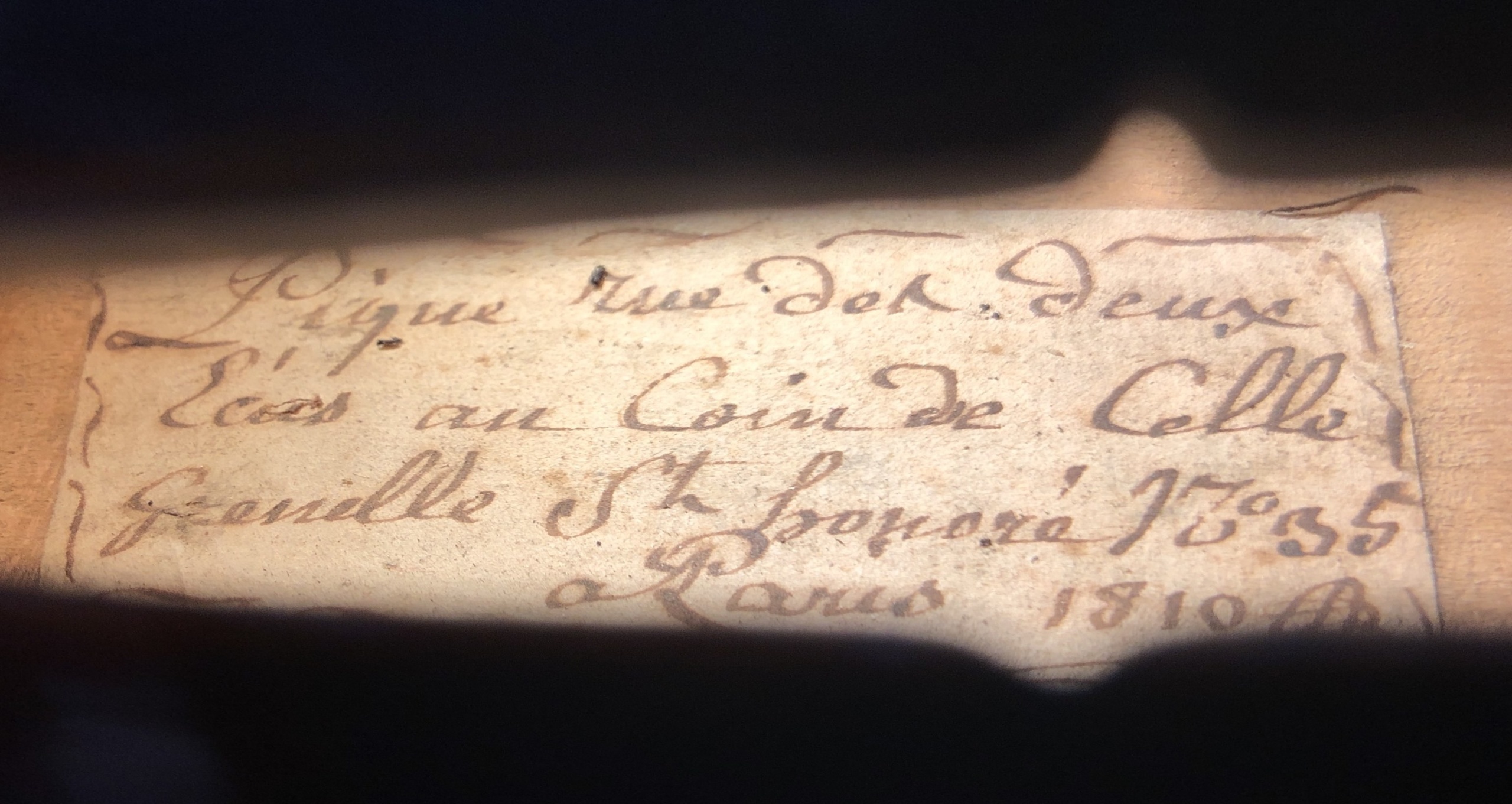
The original manuscript label with cursive script and a hand-drawn border.
The handwritten label is original to the instrument. The cursive script stating the maker’s name, address and the date is framed by a hand-drawn border. Most other Parisian makers of the period used printed labels, but Pique, to the best of our knowledge, used only a handwritten label like the one in this violin. An inscription on the upper inside back is written in the same hand and reads “Pique, a Paris, 1810.” Following both the label text and the inscription is a monogram or initials.
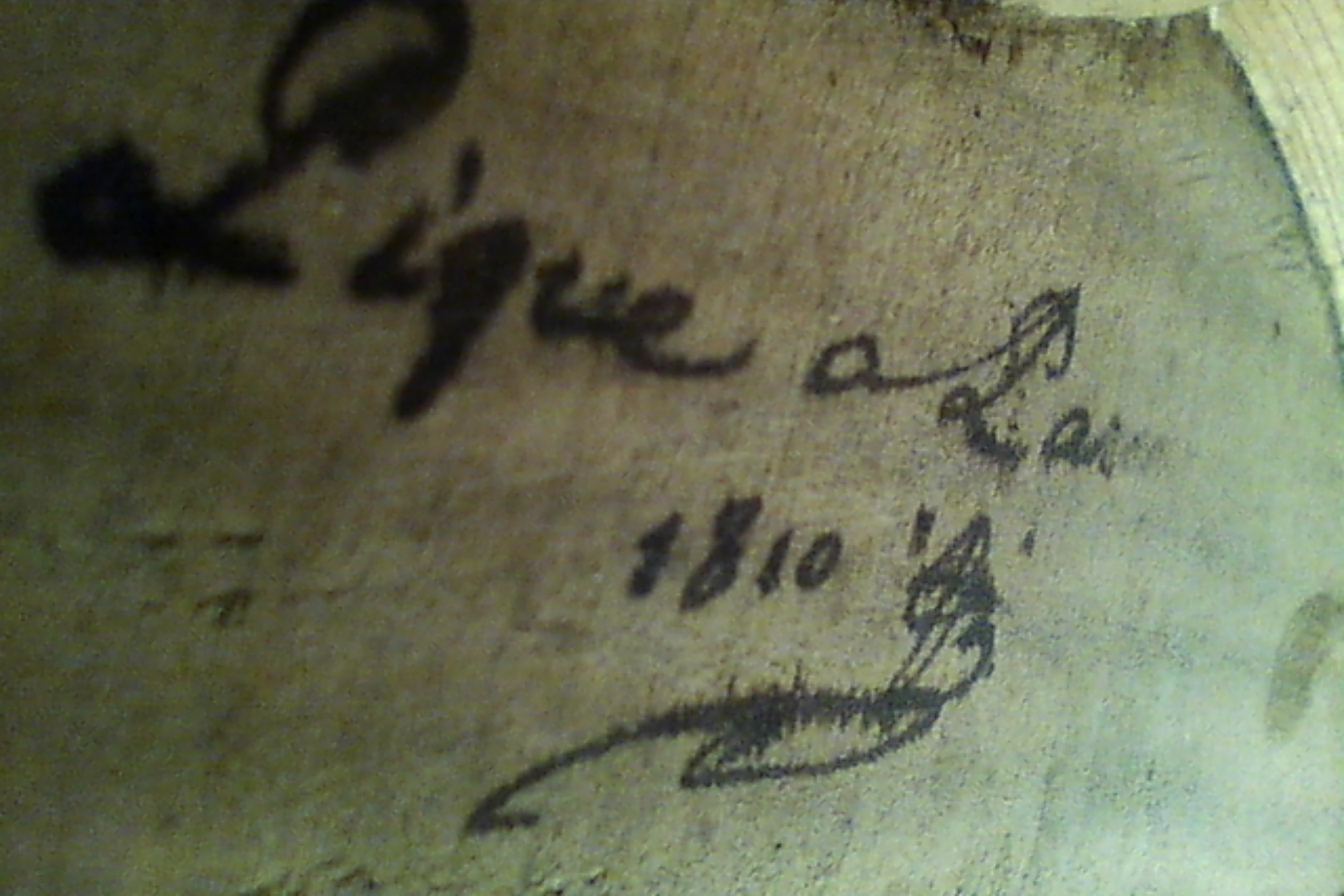
An internal inscription showing the maker’s monogram.
The technical aspects of Pique’s work contribute to an impression of great refinement. His instruments are at the same time exquisitely graceful and confidently powerful. While the outline of this violin is delicately scooped at the edges, it is also framed by stark purfling, with the strong blacks and unwavering inlay giving the model a robust strength. The purfling strands make short miters well before the end of each corner. The outer strand of purfle coming from the upper and lower bouts extends deep into the point for an exaggerated Stradivarian “bee-sting.” In fact, Pique’s purfling miters are often even more extreme than those of Stradivari; a common feature of Pique’s instruments is the black eyelash-like strand which curls slightly inwards towards the c-bouts and then extends far into the corners.
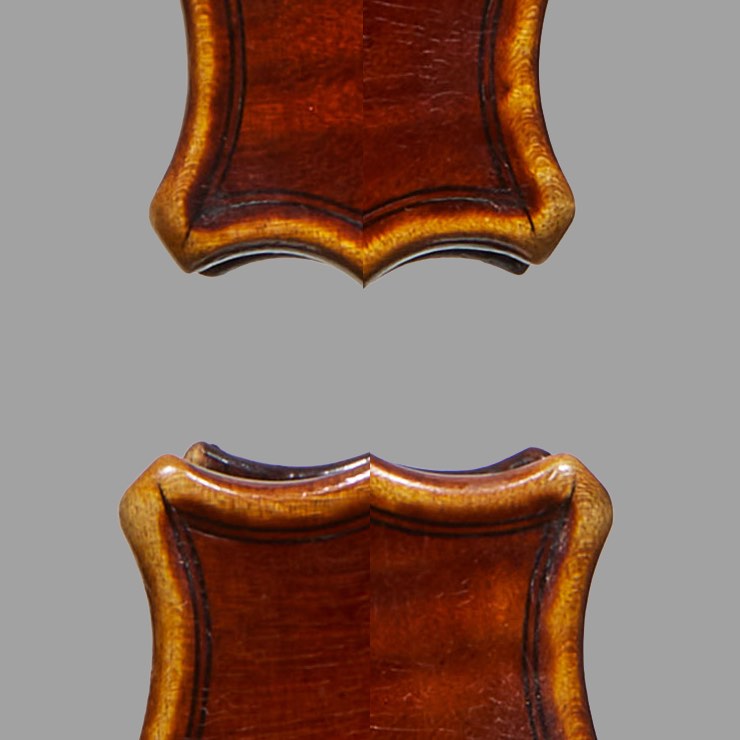
A juxtaposition of Pique’s typical purfling miter ‘bee-stings’
The boldly-set sound holes sit proudly on the front. They are meticulously accurate in form and execution and interpret the Stradivari pattern with reverence and flair. The stunning reddish-brown varnish is rich, supple and of a quality reminiscent of Lupot’s finest output.

A circular scene applied over the varnish depicts characters from the Commedia dell’Arte.
The exceptional and historically significant feature of this instrument is the circular painted scene applied above the varnish to the central section of the back. Surrounded by a gilt border and framed by sky and trees, characters from the Commedia dell’Arte dance and merrymake in a twilit pastoral scene. Pierrot, the sad clown, dances with Colombina in the foreground; Arlecchino and Polichinella frolic behind them; and a violinist and a cellist can be seen in the background to the right. The quality of the painting is extraordinary and the execution of the circular composition set atop the convex surface of the arching suggests an experienced hand. Such virtuosity can be seen in the treatment of the textiles and skin-tones, and the fluid rendering of the dancing figures. The decoration is elegant, refined and masterful.

Detail: Pierrot and Colombina dance as Arlecchino and Polichinella frolic in the background.
The painting is done in the style of Jean-Antoine Watteau (1684-1721), a French painter famed for his Rococo compositions. Many of Watteau’s imagery derived from the world of Italian comedy and theater and feature musical scenes.
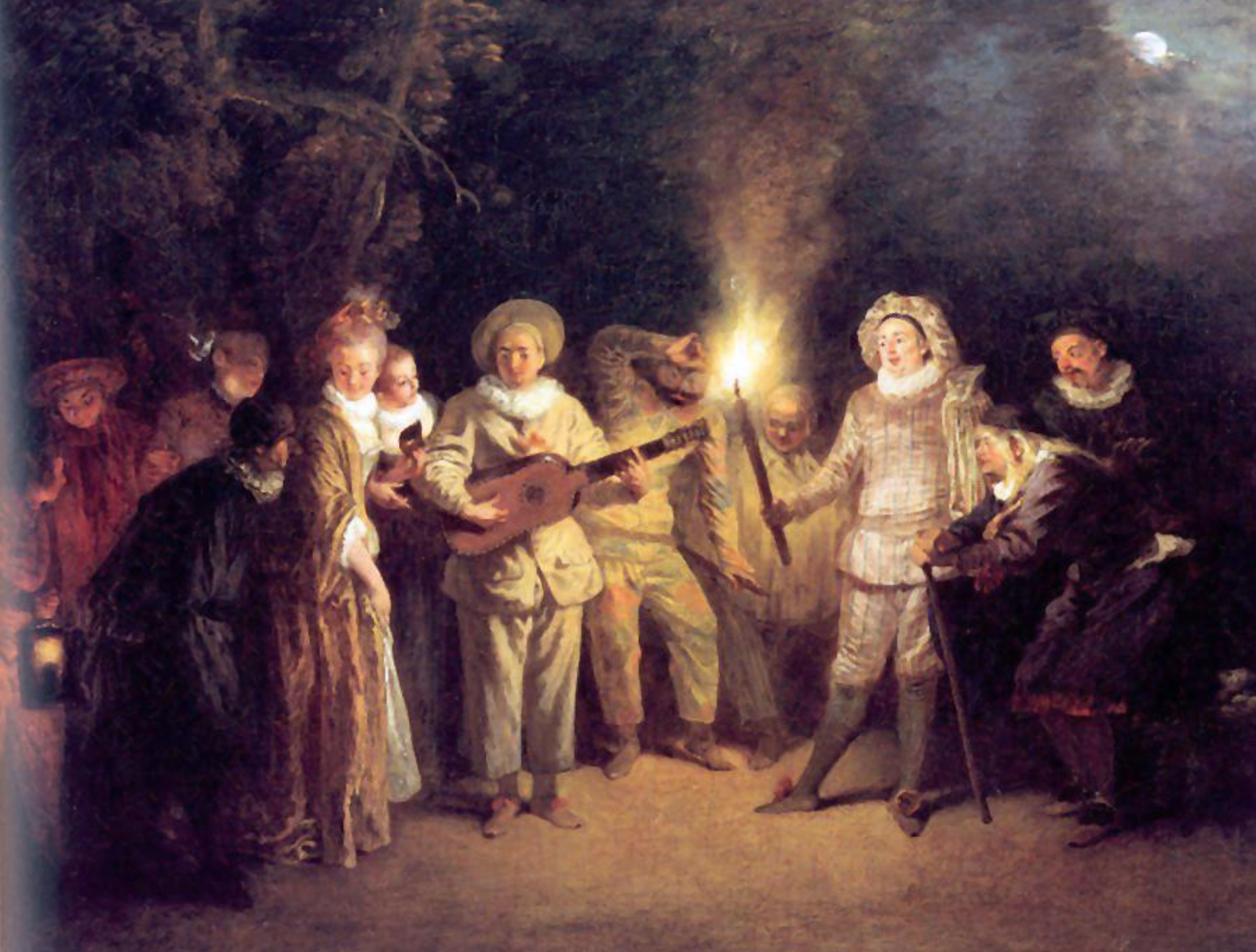
L’Amour au Théâtre Italien, 1715-1717, by Jean-Antoine Watteau. Gemäldegalerie, Berlin.
The violin’s ribs are also decorated but in lesser detail. A gilt garland with both broad and fine leaves wraps the ribs. The gilding appears to be the same as that of the gold band surrounding the image on the back, but the general detail and standard of finish is less refined.
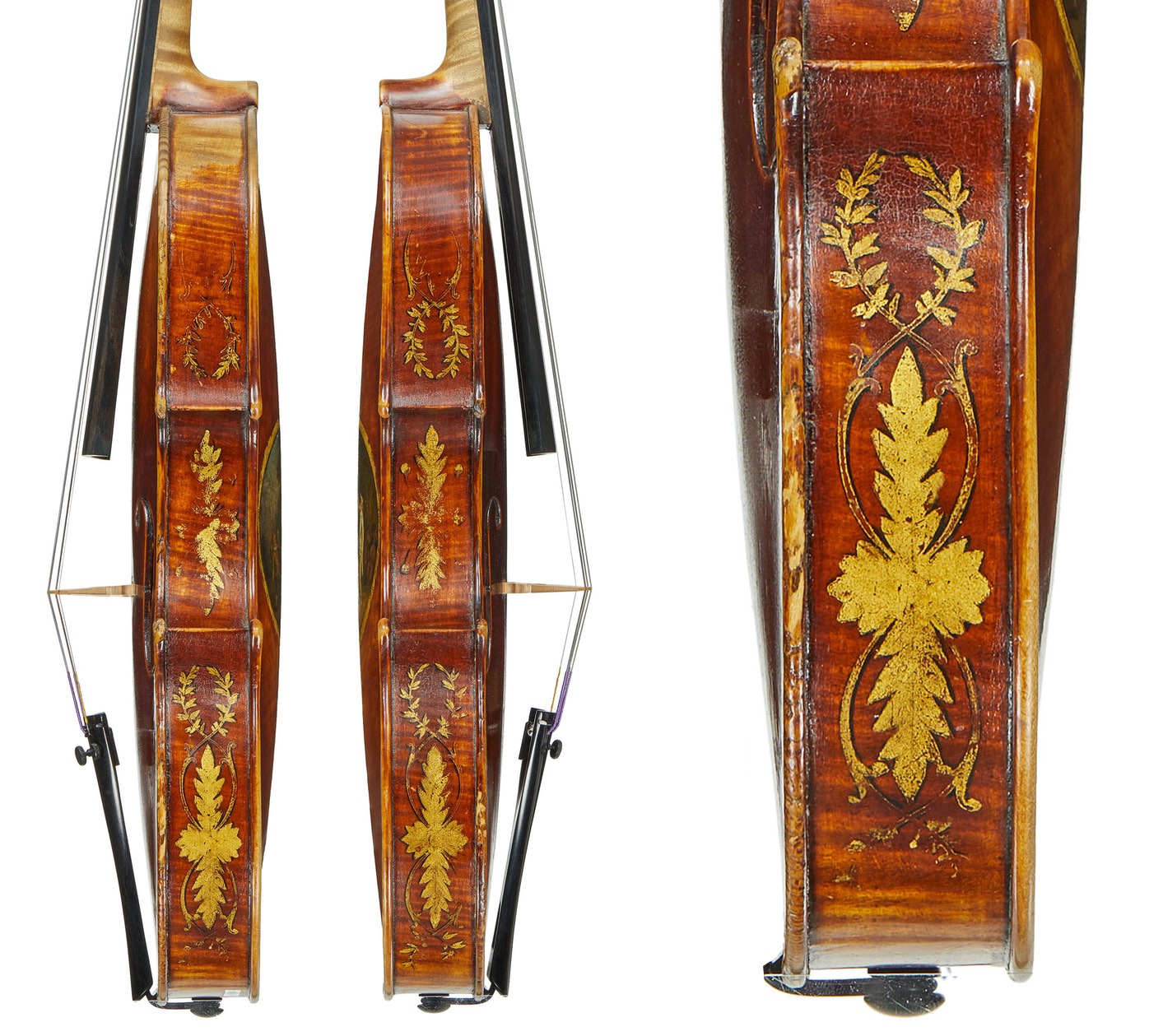
The ribs are decorated with a gilt garland of leaves and wreaths.
While early instruments from the Amati family were often decorated with heraldry and illuminated text, the practice of embellishing instruments with painting seems to have been abandoned in Italy after the mid-17th century. The practice was reprised in Paris during the 19th century, however, when the best makers began to gilt and decorate instruments for presentation and commemoration. Nicolas Lupot was the first luthier commissioned by the Conservatoire de Paris to supply decorated violins to the annual ‘Premier Prix’ laureates, a tradition which continued through the firms of Gand (C.F then C.A. then Frères), Gand & Bernardel and Caressa & Français. We don’t know how precisely these decorations were applied or by whom but it’s likely that the work was outsourced to specialized artisans and not done by the violin makers themselves.
Unlike the ‘Premier Prix’ instruments made by Lupot and Gand, among others, the decorations on this Pique violin are aesthetic rather than commemorative. We know of one other decorated violin by Pique, a late instrument dating from circa 1820 with an emblazoned laurel garland surrounding a script reading “Pique à Paris.” Given that the two instruments are so different and there is no other evidence that Pique made decorated instruments, we can assume the decoration was done by a specialized artisan, though whether Pique commissioned it or was involved in its application remains unknown.
This magnificent 1810 violin by François-Louis Pique, lot 128 in our April auction in Berlin, has everything that one would want in a great example by this maker, with the bonus of an exceptionally fine and elegant embellishment making it of unique historical importance.
The sale ends on April 25. You can view the auction lot and complete photographs here.